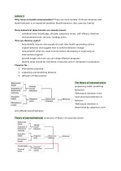Lecture 1
Why focus on health communication? There are more number of chronic illnesses and
health behavior is an important predictor (health behavior: diet, exercise, habits)
Many behavioral determinants are already known:
- individual level: knowledge, attitude, subjective norms, self-efficacy, intention
- environmental level: services, funding, policy
Why are theories useful?
- help identify reasons why people do (not) take health-promoting actions
- explain behavior and suggest how to achieve behavior change
- help pinpoint what you need to know before developing or organizing an
intervention program
- provide insight into how you can shape effective programs
- identify what should be monitored, measured, and or compared in evaluations
Theories for…
1. intervention planning
2. explaining and predicting behavior
3. diffusion of interventions
The theory of reasoned action
(explaining and/or predicting
behavior)
*Behavioral intention is the
most proximal prediction of
behavior
*Behavioral intention is
determined by subjective norm
and attitude toward behavior
Theory of planned behavior (extension of theory of reasoned action)
, The I-Change Model
*Intention is the most important
predictor of behavior
*This model divides intention and
motivation factors into different
sub-categories
*Model is really complete
Intention: the result of a conscious consideration (pros and cons of behavior, important
other’s opinion, perceived control
To predict behavior, make it as specific as possible→ use TACT to achieve specificity
(Target, Action, Context, Time) → the more specific the behavior, the more specific the
targeted intervention will be
Target= on a treadmill
Action= walking
Context= physical fitness center
Time= forthcoming month
Compatibility principle→ if you want to change certain behavior, all behavior determinants
should be aligned with that behavior (measure intention, attitude, social influence beliefs,
efficacy beliefs)
Online health communication
❖ Interventions have a public health impact if they are effective and able to reach the
target group
➢ Digital health communication has high effect and high reach
➢ Mass media communication has low effect but high reach
➢ Health counseling has high effect and low reach
❖ Online computer-tailoring (automatic process)
➢ Online questionnaire, activity tracker, mobile survey → input is needed to
tailor + relevant feedback (behavior, pros and cons, self-efficacy)
❖ Working mechanism of computer tailoring is an effective behavior change strategy
➢ increases: personal relevance, information processing, use and engagement,
behavior change
❖ Application:





